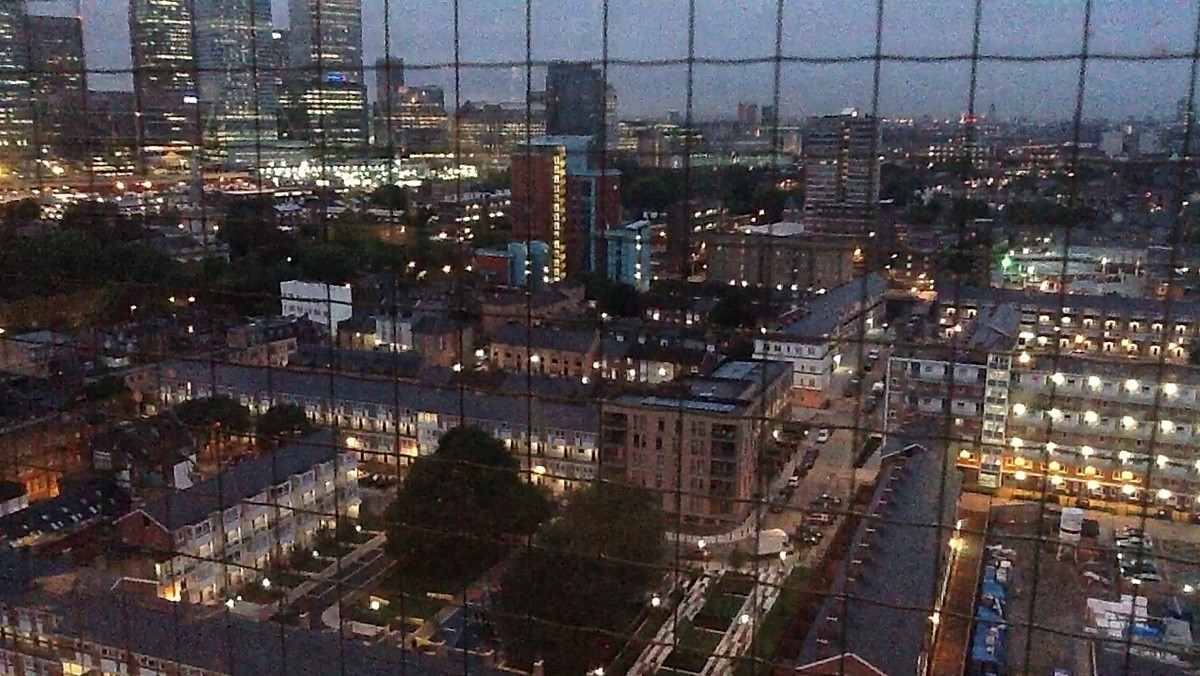
27.11.2015 19:00:00 - 24.01.2016
The Magnetic Brutalism of Post-Modern Fear
Several months after visiting a friend in Balfron Tower, Rab decided to dedicate several years of his life to this place. And so he moved into this metaphor for Brutalist architecture, which now formed the core inspiration for his future artistic endeavors. Balfron Tower, an example of the abandoned Futurist path of architecture that haunts the area surrounding the cold, gaping maw of Blackwall Tunnel, offers romantically dystopian views of Poplar’s social housing ghetto, with the silhouette of the imperial seat of power, wrapped in a glass-and-concrete shell of our debts, on the horizon. Our future is not determined by what we have managed to create, but first and foremost by our failed dreams and fantasies. We should pay more attention to them.
Fear is a positive thing in London’s architecture. The purpose of all of the city’s architecturally interesting modern buildings has been to arouse a new kind of fear in their surroundings – no longer as just a simple reminder of power, but also as a sign that this power is strange and incomprehensible, capable of making anything happen. In its cold elegance, paralyzing dynamism, and absolute sexual dominance, the terror of the metropolis becomes hypnotically attractive.
A city’s landmarks change the life of its inhabitants into an eternal trance from which death is the only escape. Today, the ruling elite keeps its citizens in a state of insecurity and the rest of the world in chaos. The subjects of this power do not fight back, because their sense of hopelessness inspires an erotically tinged resignation and acceptance of their victimhood. This kind of power is less work for the ruling class than earlier idealistic attempts at creating the illusion of job security and providing an internationally comprehensible and acceptable order. It corrupts absolutely everything by giving a chance to those closest to it, by offering participation to its loyal followers and temporary parasitism to the rest. Rab had no idea that, in the tower, he would become witness to the most perverse nuances of this strategy.
The story of how the haves got the have-littles to fight the have-nots
While living in Balfron Tower, Rab created several series of works, some of which have already been shown to the public. The exhibition at Divus is a continuation of his analytical deconstruction of the tower through the long-term photographic documentation of the inside of people’s flats. Thanks to his meticulous nature, Rab has succeeded in visiting most of the tower’s flats, getting to know tenants in a place where many neighbors do not know each other. In this way, he slowly learned the story behind the tower’s renovation, which later became one of the most scandalous examples of controlled gentrification.
We are all familiar with this grotesque urban tale. Artists, in search of cheap rents, move into a dilapidated neighborhood, thus revitalizing it and by their creative endeavors making it more attractive for others. Rents go up, and they end up victims of their own efforts, paving the way for the construction of luxury housing. But they are not the only ones to go. Disappearing with them are the neighborhood’s original inhabitants, who weren’t all that bad off before the artists’ arrival. That is why some people from unspoiled neighborhoods respond to the words “studio,” “gallery,” or “café” with a mixture of fear, anger, and loathing.
Until recently, however, gentrification was considered part of a city’s natural evolution. Although in recent years it has been helped along by investors, and the creative community’s invasion and existence (as long as it was needed) have been facilitated by various incentives, people could still innocently perpetuate the lie of gentrification’s necessity and inevitability. But what to think of gentrification that has been planned and organized from the get-go, in which town hall joins with the investor, developer, art organizations, funds for the support of culture, and the creative community in order to get rid of the original (in their view, worthless) inhabitants and cold-bloodedly split up the financial and territorial gains?
Rab Harling’s exhibition is an aesthetically consummate and simultaneously critical artistic monument to this story, which began on 6 June 2007 at the town hall of the London borough of Tower Hamlets and which continues to this day. The exhibition is held against the backdrop of a court case in which the plaintiff is trying to silence critical voices that have worked to publicize his practices. However, the trial’s evidentiary hearings and related independent investigations have revealed new facts about the sophisticated, aggressive, and cynical gentrification practices that have made this formerly revitalizing process the most repulsive example of the abuse of culture and the hypocrisy of its representatives.
Ivan Mečl
The images were taken by Rab Harling in Balfron Tower in the London Borough of Tower Hamlets between February 2011 and February 2014.
Crucial links
Vanessa Crawford, Balfron residents: “Privatising the tower will segregate the community”, Architects Journal, 3 November 2015, http://www.architectsjournal.co.uk/balfron-residents-privatising-the-tower-will-segregate-the-community/8691394.article#.Vjjv4cnOXlI.twitter
Rab Harling: http://rabharling.com/
Divus London: http://divus.cc/london/en/
Balfron Social Club: http://50percentbalfron.tumblr.com/
Petition: https://www.change.org/p/stephen-halsey-steve-stride-john-biggs-stop-privatisation-and-social-cleansing-at-balfron-tower
Links
vimeo.com/104439481
balfrontower.org
http://www.eastendreview.co.uk/2015/03/24/balfron-tower-poplar-harca/
http://www.theguardian.com/artanddesign/architecture-design-blog/2014/sep/26/wayne-hemingways-pop-up-plan-sounds-the-death-knell-for-the-legendary-balfron-tower
http://novaramedia.com/2013/08/social-cleansing-in-tower-hamlets-interview-with-balfron-tower-evictee/
http://parliamentlive.tv/event/index/667e22e7-c184-4d12-a33a-07a0e9737a07?in=15:58:30&out=16:05:21
http://www.morningstaronline.co.uk/a-2a72-Balfron-Tower-Not-for-the-likes-of-us/#.Vj9kL67hDcM
https://www.change.org/p/stephen-halsey-steve-stride-john-biggs-stop-privatisation-and-social-cleansing-at-balfron-tower
http://www.historicengland.org.uk/listing/the-list/list-entry/1334931
https://municipaldreams.wordpress.com/2014/10/21/balfron-tower-poplar-2/
http://www.ucl.ac.uk/urbanlab/events/CM2014-balfron-tower
http://www.wharf.co.uk/news/local-news/poplar-harca-accused-pushing-out-10223686
http://www.wharf.co.uk/news/local-news/balfron-tower-upgraded-grade-ii-10272658